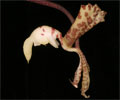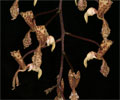|
|
|
|
|
| |
Flasks of
Gongora scaphephorus 'MC5185' × self |
|
| |
|
|
| |
| Number: |
TN6778 |
| Name: |
Gongora scaphephorus 'MC5185' × self
|
| Type: |
self (What's that?) |
|
Seed Donor: |
Troy C. Meyers
|
|
Click to Enlarge

Pod Parent Flower |
Click to Enlarge

Pod Parent Inflorescence |
Click to Enlarge

Pod Parent Inflorescence |
|
|
|
| |
Comments: Parent plant: One of the offspring from our TN3367 effort of 2002.
For additional origin/habitat information supplied courtesy of
Charles and Margaret Baker, see further below, near the bottom of this page.
|
Temperatures we attempt to use in the lab & greenhouse:
| For Species: |
|
Spring, Summer, Autumn, Winter: days average 73°F, nights 56°F; best fit is Cool-Intermediate 75-58°F
(Source:
Baker's Web OSC) |
|
About the name...
| Etymology of |
Gongora |
|
Named for Don Antonio Caballero y Góngora, viceroy of New Granada (Colombia) during the 18th century.
(Source:
Pridgeon 1992) |
| Etymology of |
scaphephorus |
|
From latinized Greek "scaphephorus" carrying a basin, a boat.
(Source:
Mayr & Schmucker 1998) |
| Pronunciation of |
Gongora |
|
GON-goe-ra
(Source:
Pridgeon 1992) |
|
If you would like to direct someone to this web page, please copy and paste this URL into your email:
http://troymeyers.com/d?016778
| Flask Information |
| Availability: |
We have sold all of the flasks for this item. |
| You should: |
Consider getting individual plants or compots instead of a flask.
You can place a "Notify Flask Recipients" Request, and either we or a flask recipient may contact you when plants are available.
You may also place a "Notify Retries" Request, and if an identical pollination (the same parents) is done again, we'll let you know.
You may reserve a flask, but it's very unlikely you'll get one ...this could only happen if we found a flask that we didn't know we had. |
| Yield Estimate: |
60 plants (based on flask surveys done 12/04/2009 through 12/08/2009)
|
| Plantlet Sizes: |
From many flasks 40 - 140 mm plants (based on flask surveys done 04/05/2010 through 05/17/2010)
From one most recently surveyed flask 40 - 140 mm (05/17/2010)
|
|
You might also want to:
|
View the seed assay for this item.
View items of the same species.
View items of the same genus.
|
| Ordering Information |
| You are not currently logged in. |
|
You must be a registered user and be logged in to reserve a flask or place a notification request. Please log in:
|
|
|
|
|
|
| |
The origin/habitat information below is supplied courtesy of Charles and Margaret Baker
The following information is based on the name of the plant provided by the donor, and assumes that the name is correct. If the plant has been misidentified, then the following information may not be correct.
This text is copyrighted by the Bakers and may not be reproduced without permission.
ORIGIN/HABITAT: Colombia, Ecuador, and Peru. This orchid is found on the
lower eastern slopes of the Andes, most often at 1950–3600 ft. (600–1100
m). Plants generally grow on trees in humid forests, but occasionally they
are found on the ground of steep slopes or roadside banks. In Ecuador,
plants were collected in extremely wet forests at 2300–3600 ft. (700–1100
m) near Puyo in Pastaza Province and at numerous locations in
Morona-Santiago Province at 1800–3300 ft. (550–1000 m). In Peru, plants
grow in wet forests near Moyobamba in the Department of San Martín, on the
road to Tarapoto at 3750 ft. (1150 m), and in the Department of Huanúco
near Leoncio Prado above Tingo Maria at 2800 ft. (860 m). In Bolivia,
plants are found in wet forests at 2150 ft. (650 m) in the northeastern
part of the Department of Cochabamba.
More about this information and the Bakers...
|
|
|
| |
|
|
|